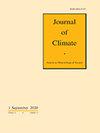北极-欧亚大陆变暖(WACE)趋势:大型集合模型模拟推论
IF 4
2区 地球科学
Q1 METEOROLOGY & ATMOSPHERIC SCIENCES
引用次数: 0
摘要
摘要 在全球变暖的同时,欧亚大陆近几十年来频繁遭遇寒冬。这种欧亚大陆冬季变冷的现象在 20 世纪晚期尤为明显,有人将其归因于内部气候变率,但这一过程至今仍难以捉摸。本研究通过研究多模式大型集合模拟,探讨了造成 1987-2006 年期间欧亚冬季变冷趋势的内部气候变率的潜在来源。模型模拟结果显示,欧亚冬季气温趋势存在较大的集合差异,集合平均值接近于零。对集合成员的比较表明,有利于欧亚大陆降温的环流模式的特点是,亚北极和阿留申地区的密封水平气压(SLP)趋势分别出现反气旋和气旋增强。这种双极海平面气压趋势与北极深部变暖、中纬度积雪变化以及热带西太平洋大气对流增强密切相关。这一结果表明,欧亚冬季降温不仅可能与中高纬度条件的变化有关,也可能与热带对流的变化有关。还讨论了热带引起的阿留申低纬度加深的可能机制。本文章由计算机程序翻译,如有差异,请以英文原文为准。
Warm Arctic-Cold Eurasia (WACE) trend: inference from large ensemble model simulations
Abstract Concurrent with global warming, the Eurasian continent has experienced frequent cold winters in recent decades. Although still debatable, such Eurasian winter cooling, which was particularly pronounced in the late 20th century, has been attributed to internal climate variability, the process of which remains elusive. By examining multi-model large ensemble simulations, this study explores the potential sources of internal climate variability responsible for the Eurasian winter cooling trend over 1987–2006. Model simulations show a large ensemble spread in the Eurasian winter temperature trend with an ensemble mean close to zero. A comparison of the ensemble members shows that a circulation pattern favorable for the Eurasian cooling is characterized by the anticyclonic and cyclonic enhancements of seal level pressure (SLP) trend in the sub-Arctic and Aleutian regions, respectively. This dipolar SLP trend is closely related to the deep Arctic warming, the change in midlatitude snow cover, and the enhancement of atmospheric convection over the tropical western Pacific. This result suggests that the Eurasian winter cooling is likely associated not only to the changes in mid- to high-latitude conditions but also to the changes in tropical convection. The possible mechanism of the tropically-induced Aleutian low deepening is also discussed.
求助全文
通过发布文献求助,成功后即可免费获取论文全文。
去求助
来源期刊

Journal of Climate
地学-气象与大气科学
CiteScore
9.30
自引率
14.30%
发文量
490
审稿时长
7.5 months
期刊介绍:
The Journal of Climate (JCLI) (ISSN: 0894-8755; eISSN: 1520-0442) publishes research that advances basic understanding of the dynamics and physics of the climate system on large spatial scales, including variability of the atmosphere, oceans, land surface, and cryosphere; past, present, and projected future changes in the climate system; and climate simulation and prediction.
 求助内容:
求助内容: 应助结果提醒方式:
应助结果提醒方式:


